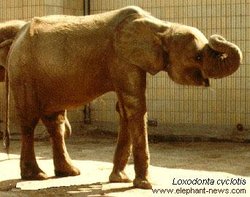Forest Elephant
|
|
| Forest Elephant Conservation status: Endangered | ||||||||||||||
|---|---|---|---|---|---|---|---|---|---|---|---|---|---|---|
 | ||||||||||||||
| Scientific classification | ||||||||||||||
| ||||||||||||||
| Binomial name | ||||||||||||||
| Loxodonta cyclotis Matschie, 1900 |
Until recently, it was thought that the so-called Forest Elephant (Loxodonta cyclotis) was simply a subspecies of the African Savannah Elephant (Loxodonta africana). DNA testing has now shown that there are in fact three extant elephant species: the two African types (formerly considered to be separate populations of a single species, the African Elephant) and the South Asian species, known as the Indian or Asian Elephant.
Differences include the Forest Elephant's long, narrow mandible (the Savannah Elephant's is short and wide), its rounded ears (a Savannah Elephant's ears are more pointed), a different number of toenails, different tusks, and considerably smaller size. Male Forest Elephants rarely exceed 2.5 metres (8 feet) in height, while Savannah Elephants are usually over 3 metres (just under 10 feet) and sometimes almost 4 metres (13 feet) tall.
Late in the 20th century, conservation workers established a DNA identification system to trace the origin of poached ivory. It had long been known that the ivory of Forest Elephants was particularly hard, with a pinkish tinge, and straight (whereas that of the Savannah Elephant is curved). The DNA tests, however, indicated that the two populations were much more different than previously appreciated—indeed, in its genetic makeup, the Forest Elephant is almost two-thirds as distinct from the Savannah Elephant as the Asian Elephant is.
